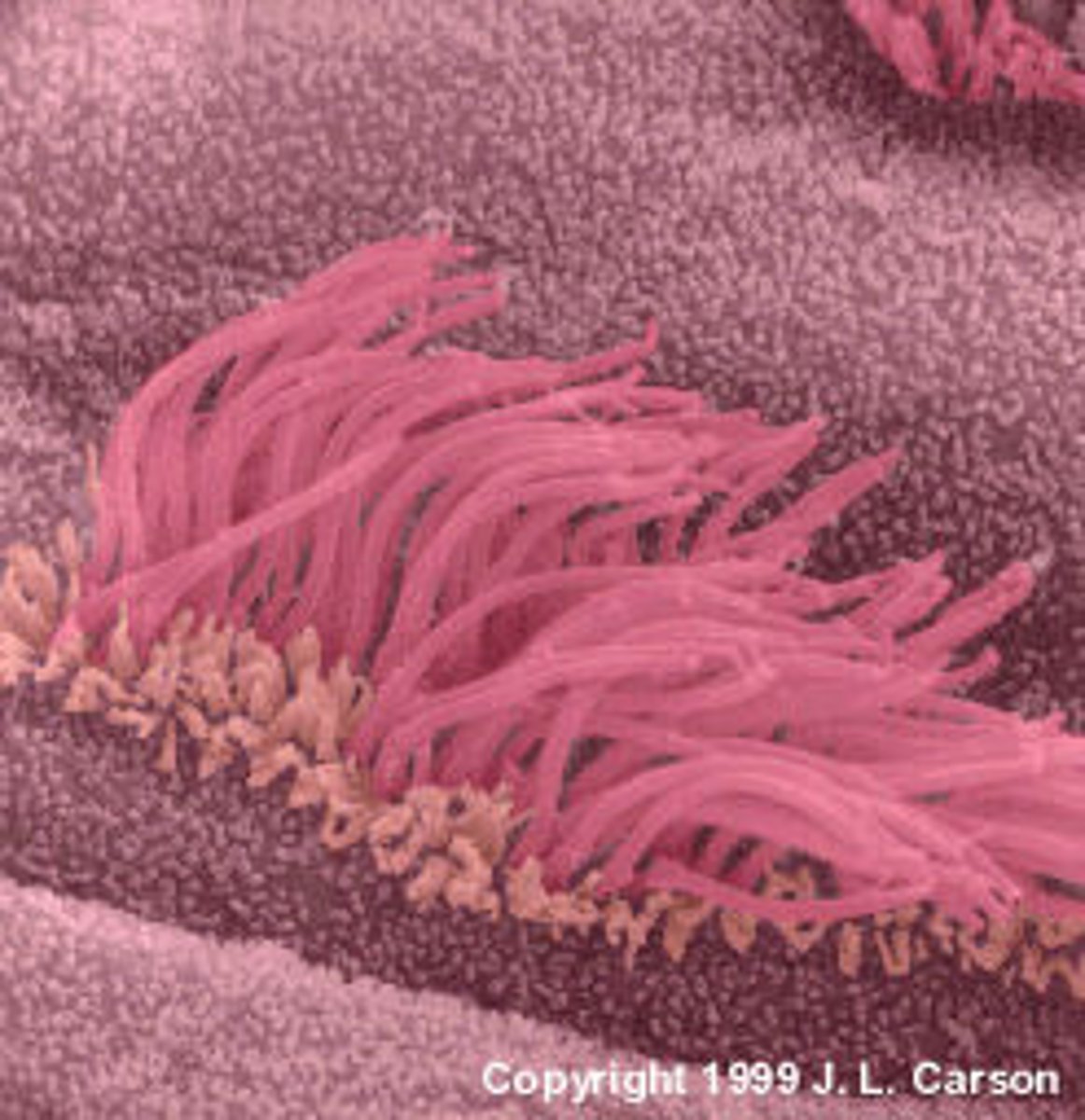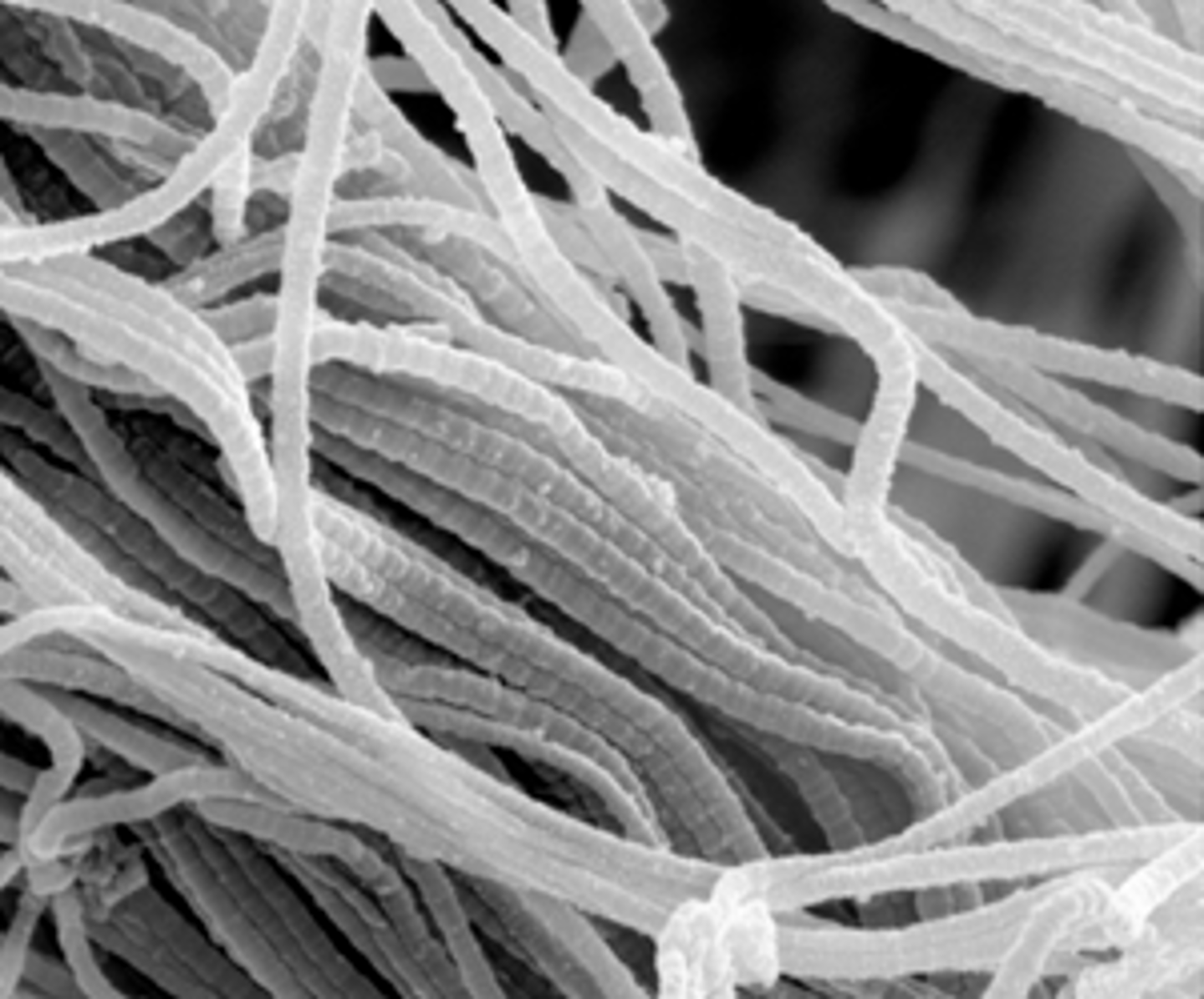Anat 337 Exam 1
1/236
There's no tags or description
Looks like no tags are added yet.
Name | Mastery | Learn | Test | Matching | Spaced |
|---|
No study sessions yet.
237 Terms
rostral
near or towards the nose

caudal
near or towards the tail

anatomical position
body standing upright, feet at shoulder width and parallel, toes forward, upper limbs are along each side and the palms of the hands face forward

neoplasia
abnormal cell proliferation
four tissues
epithelial, connective, muscle, nervous
functions of epithelial tissue
protection
selective permeability
diffusion
absorption (transcellular transport)
secretion
sensation
surface parallel transport

epithelial protection
body's first line of defense against chemical, physical, and biological wear and tear

epithelial selective permeability
epithelial cells act as gatekeepers allowing selective transfer of material
either diffusion or absorption/transcellular transport (processed to some degree before being released to blood or underlying tissue)

epithelial secretion
many epithelial cells produce and secrete specific chemicals onto their apical surface
epithelial sensation
specialized epithelial cells can detect light, taste, sound, smell, and hearing
epithelial surface parallel transport
transport of substances across the free surface of epithelium thanks to cilia

features of epithelial tissue
highly cellular, avascular, regeneration

cilia
extensions from apical surface of cell that beat in unison to move fluids as well as trapped particles across the surface in surface parallel transport

microvilli
extensions that serve to increase the surface area of the apical aspect of the cell for absorption; more surface area means more space for substances to contact the apical surface and be absorbed into cell for transcellular transport

simple squamous
single layer of flat, thin cells
allows materials to pass through quickly via simple diffusion
located in places we need substances to pass quickly, e.g. lung alveoli

simple cuboidal
single layer of cuboidal cells, may have microvilli
allows secretion and absorption
located to allow space for intracellular processing of absorbed substances and not overly-thick secretions, e.g. certain glands, kidney tubules

simple columnar
single layer of tall cells, may have microvilli
allows secretion and absorption
located to allow space for intracellular processing of absorbed substances, e.g. digestive tract

pseudostratified columnar
single layer of different size cells, only some reaching the surface, containing cilia on apical surface
allows surface parallel transport and secretion of mucous
located to move substances along the surface of the epithelium without smooth muscle, e.g. trachea

stratified squamous
multiple layers of flat cells
allows protection
located to provide more layers before damage reaches underlying tissue, e.g. skin, esophagus

transitional
special epithelium with layers of epithelial cells that stretch when the organ is distended
allows urinary organs to expand and stretch
located in bladder, ureters, urethra

gland
structure made up of one or more cells modified to synthesize and secrete chemical substances

endocrine gland
ductless gland that releases hormones directly into surrounding tissues and bloodstream
highly vascularized, can only affect target cells that have receptors for specific hormones, hormones have different effects on different target cells

hormonal secretions
happen in response to another hormone
neural secretions
happen in response to a nerve impulse
e.g. adrenal glands are stimulated by nerves to secrete epi/norepi
humoral secretions
happen in response to something in the blood
e.g. detecting low BGM means secreting glucagon to raise BGM
exocrine gland
secretions leave through a duct that opens directly or indirectly to a surface
e.g. skin, GI tract, respiratory tract
goblet cells
unicellular exocrine "gland" interspersed between columnar or pseudostratified columnar epithelial cells of mucous membranes; release mucin

basal lamina
superficial layer that restricts movement of proteins and other large molecules from underlying connective tissue into the epithelium

tight junctions
holds cells together so there is no extracellular space between them
prevents substances from moving between cells, thus forcing them to go through cells
allows epithelial to act as a selective barrier or gatekeeper

adhering junctions
acts like a belt holding the epithelial cells together for support and stability of tissue

desmosome
holds cells together like a push button on a jacket to provide support and stability of tissue
gap junction
forms an intercellular passageway between the membrane of adjacent cells to facilitate movement of small molecules and ions between the cytoplasm of adjacent cells
allows easy cell to cell communication

carcinoma
malignant tumor of epithelia

adenocarcinoma
malignant tumor of glandular epithelia

metaplasia
normal epithelia from one area is replaced by another form of epithelial not typical for that region

connective tissue
most diverse, common, and widely distributed tissue
functions of connective tissue
support
protection
defense
transport
energy storage

connective tissue protection
CT provides cushioning as well as bony projections of organs

connective tissue defense
specialized cells in CT defend the body from microorganisms that enter the body

connective tissue transport
transport of fluid, nutrients, waste, and chemical messengers is ensured by specialized fluid CT, such as blood and lymph

connective tissue energy storage
adipose cells store surplus energy in the form of fat and contribute to thermal insulation of the body

connective tissue proper
largest category of CT, primary cell type is fibroblasts

what three fibers do fibroblasts secrete?
collagen, elastic, and reticular fibers

collagen fibers
great tensile strength, resist stretching, e.g. ligaments and tendons

elastic fibers
contain elastin to return to original shape after stretch and compression

reticular fibers
create a structure and allow space for an organ, strong enough to make a shape while also still allowing things to move

loose connective tissue
found between many organs where it acts to both absorb shock and bind tissues together; areolar, adipose, and reticular
areolar CT
contains all cell types and fibers distributed randomly, fills space, highly vascular
located in muscle fibers, blood and lymph vessels, underlies most epithelia

adipose CT
highly vascular, functions for insulation, energy, water, hormone storage, and support and protect organs, very little extracellular matrix
located in kidneys, neck, clavicle

reticular CT
located where there is a lot of blood flow and large cells needing to go through
located in the spleen

dense connective tissue
contains more collagen fibers and displays greater resistance to stretching than loose CT; dense regular, dense irregular, and elastic CT

dense regular CT
fibers are parallel to each other, enhancing tensile strength and resistance to stretching in the direction of fiber orientations

dense irregular CT
direction of collagen fibers is random, gives tissue greater strength in all directions rather than one particular direction and withstands tension in multiple directions

elastic CT
contains elastin and collagen fibers, main functions are stretch and recoil

skeletal muscle
large, long, cylindrical
striated
voluntary movement
muscles acting on limbs, trunk, and face
movement or stabilization, heat production, protect internal organs
no mitosis but can regenerate

smooth muscle
small, spindle-shaped with tapered ends
not striated
involuntary movement
walls of many internal organs and passageways
move food, urine, secretions and control diameter of vessels
capable of mitosis and regeneration

cardiac muscle
small, short, branched
striated
involuntary movement
heart wall
circulates blood
connected by intercalated discs with gap junction
not capable of mitosis or regeneration

epimysium
sheath of dense, irregular CT surrounding a muscle

perimysium
sheath of CT surrounding each individual fascicle

endomysium
sheath of CT surrounding each individual muscle fiber

fascicle
bundle of muscle fibers

myofibrils
cylindrical structures that runt he entire length of the muscle fiber

myofilaments
actin and myosin proteins in myofibrils

sarcomere
unique individual groupings of actin and myosin

sharpey's fibers
collagen fibers penetrating deep into cortical bone

neuromuscular junction
site where a motor neuron meets the muscle fiber

motor unit
group of muscle fibers in a muscle innervated by a single motor unit controls only muscle fibers of the same type

all-or-none principle
when a motor neuron is stimulated, all muscle fibers in its motor unit will contract; as more motor units are recruited and contract, the muscle contraction grows stronger

slow oxidative (SO) fibers
fibers contract slowly and are aerobic
less power, greater endurance, need greater blood supply

fast glycolytic (FG) fibers
fibers contract quickly and are anaerobic
more power, rapid instead of endurance, use glycogen stores

hypertrophy
resistance training leads to increased size of myofibrils and muscle cells in muscle fibers

two main classes of cells in nervous system
neurons and neuroglia
neurons
transmit information through the body via electrochemical signals
last a lifetime
don't divide
high metabolic rate

neuroglia
cells that support neurons, six different types - four found in the CNS, two found in the PNS
synapse
gap between two neurons or a neuron and its target across which an impulse is transmitted by neurotransmitters

cell body (soma)
most of the cytoplasm, organelles, and nucleus of a neuron
"thinking" part

dendrite
branches receiving most of the input from other neurons and carry it to cell body

axon
only one per neuron, a fiber that emerges from cell body and proejcts to target cells to propagate nerve impulse

pseudounipolar neurons
axon emerges from cell body and splits so that it can extend a very long distance
one end of the axon has dendrites, other end forms synaptic connections with a target
exclusively sensory neurons

bipolar neurons
two processes extend from each end of the cell body opposite to each other
one is axon and one is dendrite
found in olfactory epithelium and retina

multipolar neurons
most common neurons in the body with one axon and two or more dendrites

convergence
multiple presynaptic neurons converge to send a signal to ONE postsynaptic neuron
this amplifies the signal and causes firing

divergence
one presynaptic neurons sends a signal to MANY postsynaptic neurons
this sends the same information to multiple locations

astrocytes
most abundant glial cells in CNS
regulate the environment around neurons and take up/breakdown neurotransmitters or ions in the fluid surrounding the neurons
contribute to BBB
act as CT of the brain
form scar tissue
regulate inflammatory response
involved in synapse formation and neuronal growth
propagate Ca signals involved with memory

microglia
smallest and least abundant in CNS, considered immune cells of the brain
phagocytize debris from dead/dying cells and invading microorganisms around brain and spinal cord

oligodendrocytes
myelinate axons in the CNS
can myelinate multiple parts of multiple axons
inhibit regeneration of neurons

ependymal cells
filter blood to make CSF
Schwann cells
myelinate axons in PNS
surround unmyelinated axons in PNS
can only myelinate one part of one axon at a time

satellite cells
surround cell bodies of neurons in the PNS, isolating them and protecting them from surrounding tissue

wallerian degeneration
in an injury to an axon, the part of the axon distal to the cell body breaks down in a process called fragmentation
portion between the cell body and injured area can stay alive and remain healthy
macrophages clean up damaged cells
Schwann cells form cord/regeneration tube to guide axon back to its target
if there is too much damage, it may not happen at all
not possible in the CNS

nucleus/center
group of neuronal cell bodies in the CNS
ganglion
group of neuronal cell bodies in the PNS
tract
bundle of axons or fibers in CNS
nerve
bundle of axons or fibers in PNS
general somatic sensory
sense of touch, pressure, pain, temperature, and propioception
general somatic motor
voluntary movement by skeletal muscles
general visceral motor
involuntary movement of our cardiac and smooth muscle and secretion from glands
general visceral sensory
monitoring and sensing unconscious information primarily coming from our organs and glands
nervous vs endocrine system
neurotransmitters in synaptic cleft vs hormones in blood stream
rapid vs slow response
short, localized effects vs long, widespread effects
meninges
three layers of connective tissue in which the brain and spinal cord are wrapped
